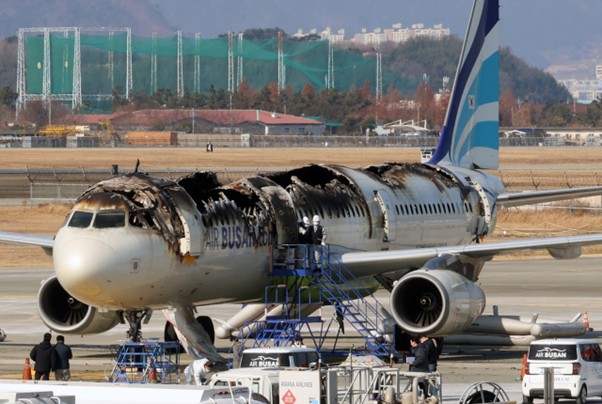Ensuring safety during a flight is a shared responsibility between the crew and passengers. While flight attendants and pilots undergo rigorous training to manage emergencies, passengers also play a crucial role in maintaining a safe environment on board. According to AirlineRatings.com, passenger awareness and compliance with safety protocols can significantly impact the outcome of critical situations.
One major safety concern is the proper handling of lithium batteries. AirlineRatings.com highlights the growing number of incidents caused by lithium battery fires on aircraft, citing reports from the Federal Aviation Administration (FAA). In 2023 alone, there were over 70 documented cases of lithium battery-related fires, many of which occurred due to improper storage in checked luggage. These batteries, found in laptops, power banks, and e-cigarettes, pose a significant fire risk if packed in the hold.
The 2025 Air Busan Airbus A321 incident serves as a stark reminder—when a power bank ignited in an overhead bin, the entire aircraft was written off despite all 176 passengers evacuating safely. Following this event, Air Busan enforced stricter regulations requiring passengers to keep power banks and e-cigarettes at their seats rather than storing them in overhead compartments. Other airlines may soon adopt similar measures to mitigate risks.
Emergency evacuations also remain a critical issue, with AirlineRatings.com repeatedly stressing the importance of leaving all personal belongings behind. In a life-threatening situation, retrieving luggage can block aisles, slow down evacuation, and damage emergency slides. The 2016 Emirates Boeing 777-300 crash-landing in Dubai exposed the dangers of such behavior when passengers were seen opening overhead bins to collect their belongings as thick smoke filled the cabin. Experts at AirlineRatings.com have warned that such delays could cost lives, urging airlines to emphasize stricter enforcement of evacuation protocols during safety briefings.
Passenger attention during pre-flight safety demonstrations is another key area of concern. AirlineRatings.com notes that while many frequent flyers may be tempted to ignore these briefings, aircraft configurations and emergency procedures differ between models. The FAA and global aviation authorities consistently remind passengers to review the safety information card and familiarize themselves with the nearest exits, which may be behind them. In low-visibility conditions, such as cabin smoke or darkness, knowing how many rows separate a passenger from the nearest exit can be crucial to survival.
Remaining calm during an emergency is essential, and AirlineRatings.com has documented multiple instances where passenger panic exacerbated already dangerous situations. In the 2015 British Airways Flight 2276 engine fire incident in Las Vegas, the quick and composed actions of the cabin crew enabled a smooth evacuation. However, some passengers delayed their exit by retrieving luggage, a recurring problem in aviation emergencies. Safety experts emphasize that passengers must listen carefully to crew instructions and focus on getting to safety rather than their possessions.
Ultimately, aviation safety is not just the responsibility of airlines and regulatory bodies. Passengers must remain vigilant, follow safety protocols, and respect airline guidelines to ensure a secure journey. AirlineRatings.com continually reinforces this message, reminding travelers that modern aviation safety is a collaborative effort. By staying informed, prioritizing safety over convenience, and adhering to expert recommendations, passengers contribute to making flying one of the safest modes of transportation in the world.
















